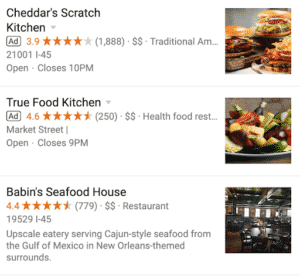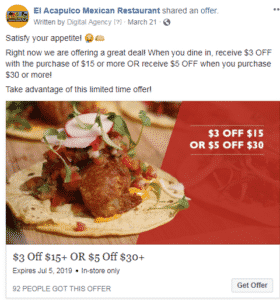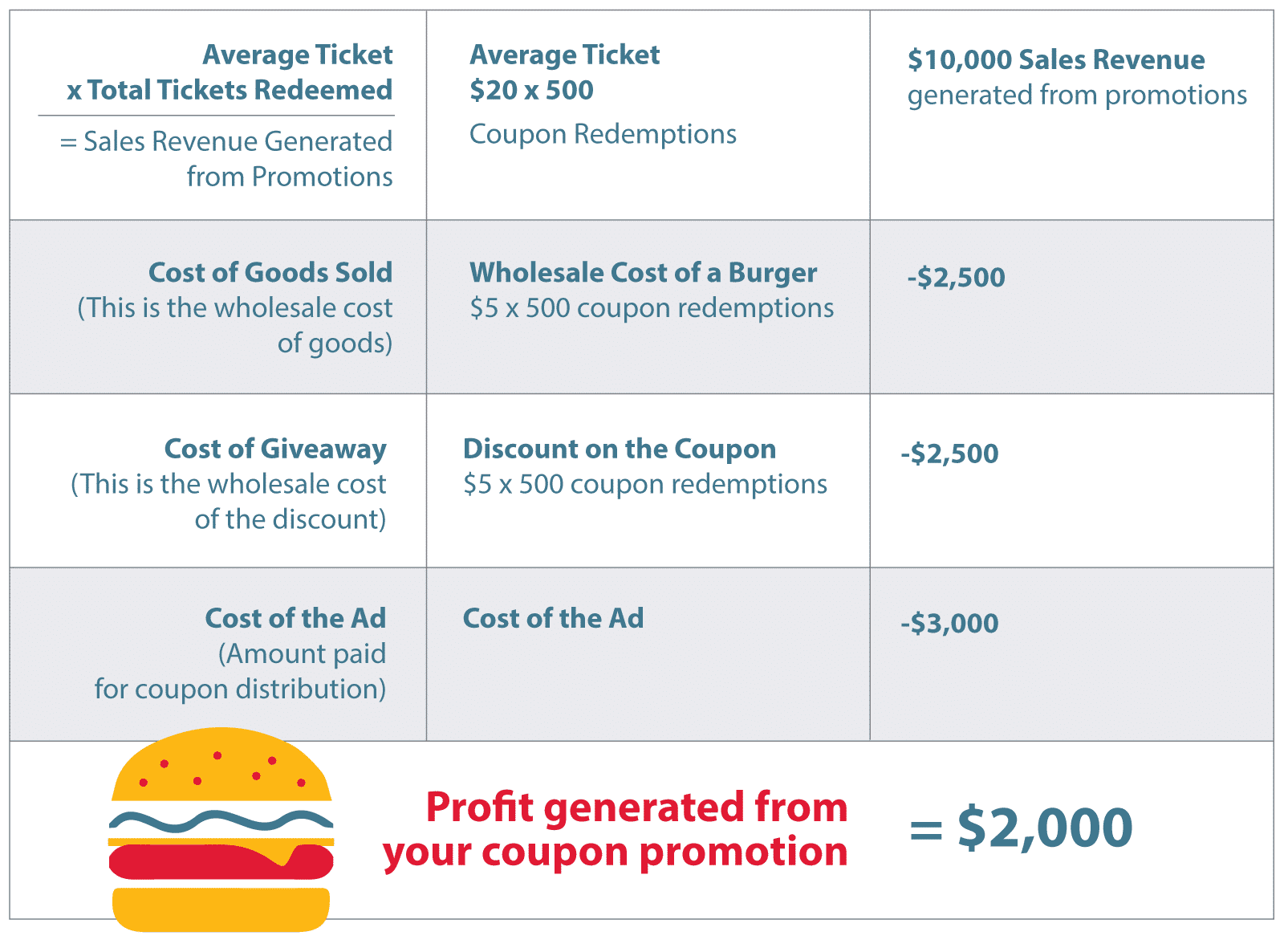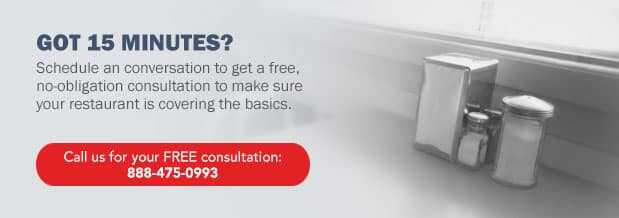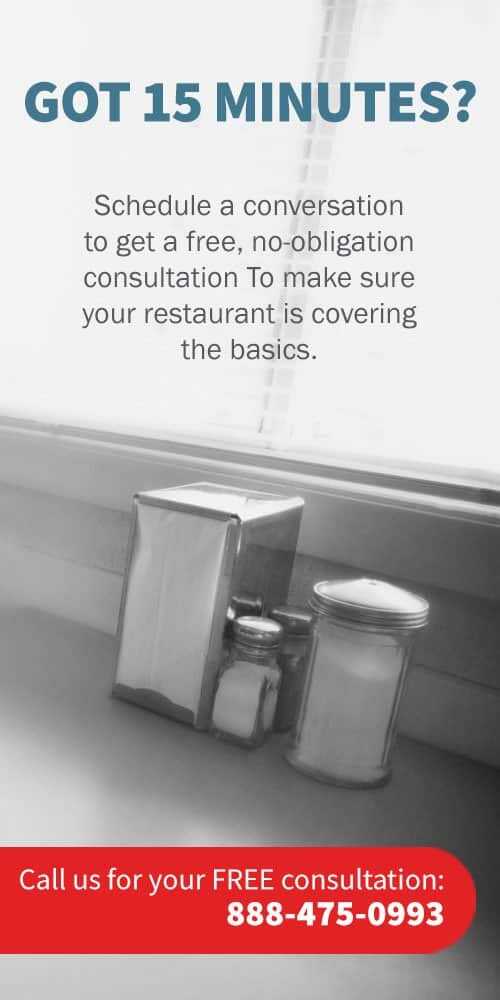This guide will walk you through how to market your restaurant in a way that brings in new customers and makes sure they keep coming back.
For most of the restaurant industry, getting the word out doesn’t happen on its own. You need a rock-solid plan to grow your restaurant’s profits and our restaurant advertising agency has the knowledge and resources to help your restaurant succeed.
Owning and running a restaurant usually means being involved in every essential task. Menu development, atmosphere, and the actual food prep are only parts of your day-to-day job!
With so much to take care of, have you ever wondered if you’re forgetting about restaurant promotions?
This guide developed by our restaurant advertising agency’s experts will help you make sure that your marketing is as tidy as your back of the house and answer your questions surrounding advertisements about restaurant offerings.
If you want the REALLY short version of this Guide, you simply need to do the following:
- Understand Where Restaurant Profits Come From
- Claim Your Local Listings
- Build Your Website
- Grab Your Social Media Accounts
- Monitor Your Online Reputation
- Start a Restaurant Marketing Paid Campaign
- Build Customer Loyalty
Download a PDF version of this guide by filling out this form, or keep scrolling to read.
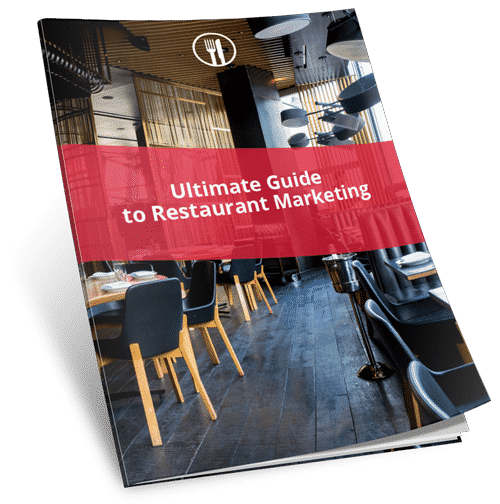
1
Strategy
Before Considering Advertising Ideas, Start with Basic Numbers
Before we start talking about how to market your restaurant, you need to gather some data about how your restaurant generates a profit. This will be important for your decision-making process as you go forward choosing your advertising options. You should have calculated and written down the following important data points:
- What is your basic profit margin, broken down by menu item?
- What is your average ticket price?
- What are the upsell opportunities? (Be very specific here)
- What does your cash flow look like for the next 6 months?
- What will happen if you don’t reach your growth goals? For example, if you don’t grow by 20% next year, you won’t be able to open a second location, hire a specific position, etc.
These numbers should always be top of mind as they are critical to running a restaurant as a successful business. The good news is that they are the exact same ones you need to set a restaurant marketing goal. A good overall profit margin (7%+) indicates that you might consider driving more people to the restaurant by enticing them with discounts. If there is a particularly high-profit item on the menu, you can promote that particular item through marketing and through your staff. The more info you have, the better your decisions will be.
RATE Your Current Paid Marketing Programs
Next, you need to analyze paid marketing tactics, including online media platforms. We use the mnemonic “RATE” to help evaluate which marketing ideas are the most cost-effective to help you spread the word.
RATE stands for:
Repitition
How often will people see your ad?
Appeal
What will entice people to eat at your restaurant?
Targeting
Does your ad reach the right people?
Exposure
Will your ad actually be seen?
Let’s take a look at how some common restaurant advertising ideas stack up. The following information is “typical” but you can add your region’s actual numbers in the grid.
| Repetition | Appeal | Targeting / Reach | Exposure | Cost | |
|---|---|---|---|---|---|
| Google Ads (including map ads) | Search Ads: Appear as someone performs a Google search. Impressions are limited by budget. Display Ads: Appear in ad space on websites who participate on Google Display Network. | Search Ads: Text ads appear as people are actively searching for dining options. Can include text discount offers. Display Ads: Full- color ad w/ coupon | Depends on CPC and budget | Search Ads: Appear directly in a user's search results. Display ads: Continuously appear in various websites that the user visits. | Less than $1-$5+ per click (CPC= cost per click) |
| Facebook Advertising | 1-4x per month | Full-Color Ad w/Coupon Discount | 20K-40K Users within 3-5 miles of your business, narrowed by demographics | Native ad in the user's newsfeed | $500 - $800/month |
| Grocery Store Receipt Advertising | 4-8x per month | Full-Color Ad w/Coupon Discount | Approx. 80K shoppers within 3-5 miles | Placed directly into the shopper's hand | $358/month |
| Newspaper | 1x per month | Black & White ad in Sunday paper | 318,085 Readers | On the driveway | $4,620 per ad |
| Radio | 5 spots per week | Audio only, must be memorable | 2+ Million listeners, Adults 25-54 | 30 second air time per spot | $3,500 per Week (not including production cost) |
| Billboard | 7-15x per month | Eye-catching Outdoor sign | 5,391,090 Population | 6 seconds of visibility | $27,050 - $151,800 per month |
Download a blank spreadsheet for your use.
When considering new advertising media, make sure to compare it to the baseline above to see where it stands. Maximizing your advertising RATE gives you the greatest return on your investment.
Now that you are armed with the information you need, let’s take a detailed dive into how to market your restaurant. In the sections below, we will look at your online footprint and then look at the progression of advertising options geared to build a steady and growing customer base with the least amount of risk.
2
Get Your Online House in Order
Snag the Low Hanging Online Marketing Fruit!
- What does your online presence look like? When a customer searches for your restaurant, what will they find?
- Is the information on your website, local listings, and social profiles consistent?
- Do you have a good reputation? Are customers reviewing your restaurant?
- Claim your local listings: Google, Bing, Yelp, Yahoo, etc… Even if you will have a marketing firm helping you, most sites will send some sort of verification that you need to provide, so get started early!
- Build your website- this is pretty obvious for most restaurant owners, but we recommend you keep a 3-1 mindset: for every $3 you spend on your website, you should plan to spend $1 PER MONTH on paid search.
- Monitor social media. If you have bad reviews, be polite, express regret that they had a bad experience (not the same as agreeing with them), and wish them luck. If you have positive reviews, BRIEFLY thank them.
1. Restaurants Must Claim Local Online Listings
When someone searches online for your restaurant, or your type of restaurant (ie: Mexican or Italian restaurants near me), they’re most likely in the process of deciding where they want to eat. Your location, hours, phone number, and menu can all play a role in getting them to pick you over a similar restaurant down the street. Most often, this information is gathered without getting to your website. Instead, search engines provide this information through 3rd party local listings such as: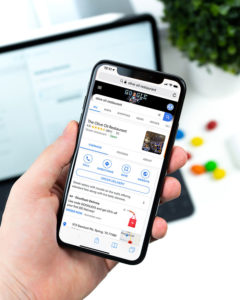
- Google Local Listing
- Bing Places (which provides information for Siri and Alexa)
- Yelp
- Trip Advisor
- YellowPages.com
2. A Good Website
Your website is an extension of your brick and mortar store. The expectation that you set on your restaurant’s website should align with reality. If a prospect walks in to your restaurant expecting fine dining and finds a bar and grill, you’ve made a bad first impression before they’ve even received their drinks! Your restaurant’s website is a representation of your brand and your personality, sometimes called your “voice.” If you use clever and fun phrases in the restaurant, use them on the website. If your restaurant features a great brick wall, include an element of that in the website design. Make it clear to visitors that they’re in the right place. And then make a few very important things easy to find:- Your Location with a link to Google Maps
- Your menu
- Your hours
- Reservations or online ordering options
- Specials or discounts
3. Online Review Management & Responses
So, there it is, for everyone to see. Someone has posted an online review. Hopefully it’s great! Sometimes it’s not. But, either way, the most important thing you need to know is that online reviews are here to stay. And, your customers are using them. In a recent study by TripAdvisor, 94% of US diners are influenced by online reviews! Your restaurant’s reputation is everywhere. Star ratings will appear in the search results for Google, Bing, Yelp and others – often before you see the actual website, as you can see in this Juicy Crab example. To keep your restaurant reviews thriving, and your reputation on the rise, you will need to: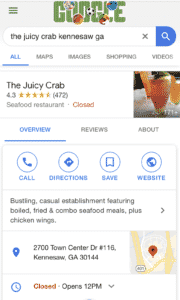
- Monitor review sites
- Engage with reviewers
- Take action to fix problems.
Monitor the Major Review Sites
The sites you must monitor for your restaurant are:- Bing
- Yelp
- Trip Advisor
Take Internal Action
Review monitoring sites will notify you when a review is posted on a third party website. Whether it’s good or not-so-great, be sure to share it with your team. For good reviews, you may want to give praise to the team that was mentioned in the review. You can even try to get your staff involved with encouraging more reviews by making it a fun contest to see who can get the most mentions in online reviews in a month. A little incentive can go a long way! If the review isn’t so great, investigate a little. Talk to your team to see what they experienced compared to what the review said. Talk with them about how to ideally handle a similar situation in the future. And then share your overall plan for improvement, without calling out specific staff, to the entire team. There may be some cases where the reviewer is really vague and you can’t help the staff learn from it. Just take note whether the bad review is a one-off situation or part of a larger trend.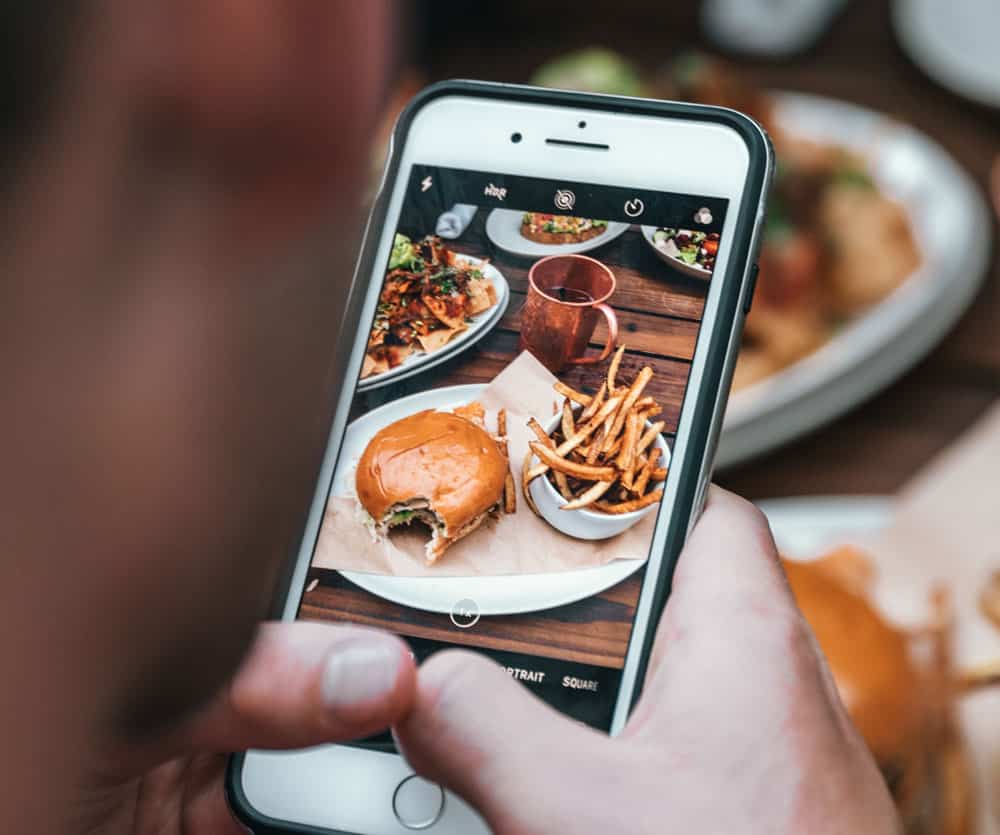
Respond to the Reviewer
It’s such a simple thing to do and it can mean everything to a reviewer. Whether they said something nice or not, they are going to remember your restaurant if you take the time to reply. When it comes to negative reviews, carefully consider your response. This isn’t just a way to address the reviewer. It will also show potential customers how you professionally and politely handle a bad experience. Some good things to include in your response are:- Show that you are apologetic for their bad experience
- Acknowledge why they are upset
- Offer a solution or tell them how you addressed the problem
4. Social Media Profiles
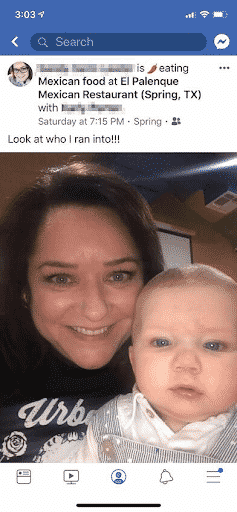 Creating and paying attention to your restaurant’s Facebook and Instagram profiles is important for a few reasons:
You start to have a following. Call them fans, call them followers; these are the people that have opted in to see updates from your restaurant on social media. As you post exciting, remarkable content, your followers will share it with their friends and family. This organic (free) marketing helps you to expand your restaurant’s name within your community.
Get more visibility when people check-in at your restaurant on Facebook. People like to talk about what they’re up to, which includes using a “check in” feature. This will place a link to your restaurant’s Facebook profile in their post. Free advertising! Make sure your profile is up-to-date and accurate. Include upcoming events, discounts, your menu, or other information that will encourage them to come to your restaurant.
Don’t have business profiles yet on social media? Learn how to get them set up by reading our blog, “How to Use Social Media to Promote Your Restaurant”.
Creating and paying attention to your restaurant’s Facebook and Instagram profiles is important for a few reasons:
You start to have a following. Call them fans, call them followers; these are the people that have opted in to see updates from your restaurant on social media. As you post exciting, remarkable content, your followers will share it with their friends and family. This organic (free) marketing helps you to expand your restaurant’s name within your community.
Get more visibility when people check-in at your restaurant on Facebook. People like to talk about what they’re up to, which includes using a “check in” feature. This will place a link to your restaurant’s Facebook profile in their post. Free advertising! Make sure your profile is up-to-date and accurate. Include upcoming events, discounts, your menu, or other information that will encourage them to come to your restaurant.
Don’t have business profiles yet on social media? Learn how to get them set up by reading our blog, “How to Use Social Media to Promote Your Restaurant”. 3
Restaurant Advertising
Once you have your online house in order...
Then (and only then) are you ready to start looking at what is considered mainstream restaurant marketing. The budgets for each of the items below can vary pretty widely depending on your location and exact type of restaurant. Moreover, any kind of restaurant advertising takes time, so you’ll need to carefully consider any ad campaign to be a minimum six month investment, and probably even longer to really understand what is working and get the right repetition with your potential customers.
1. Google Paid Search Ads
Pay Per Click ads using Google Ads can be used to put you at the top of the search results when someone is searching for “restaurants near me” or for a specific restaurant type like “italian restaurants”. These ads can appear above all the search results or in the Google map results. They appear on mobile devices (where most of these searches are done) as well as desktop computer searches. Your phone number should be included in the ad so it can be clicked and called directly from a mobile phone.
Because these are highly specific and geographically targeted, they can be more expensive per click than other types of online advertising. However, you can track results to see how many calls and clicks came to your website as a result of the ad. This will help you determine if it’s providing a return on investment.
2. Facebook Advertising
Once you’ve created your Facebook Business Page and you’re committed to making regular updates, you can start running Facebook ads to reach new audiences and increase sales.
With Facebook ads you can target new potential customers with special offers. There are a few benefits of these ads:
- You can get very specific about the target audience using demographics like gender and age.
- You can target a very specific geographic area, usually right around your restaurant.
- Offers give potential customers a sense of urgency to eat at your restaurant. As an option to a customer’s routine restaurants, or even to encourage a revisit from a regular, an offer can be just the right nudge: they get a great deal and you fill a seat. Plus, your potential customers will see your name and offer over and over, putting you at the top of their minds.
Facebook Offers Target Potential New Restaurant Customers
Facebook offers are a relatively new addition to Facebook. Where a Facebook ad displays your image and text and allows users to link somewhere, a Facebook offer creates a virtual coupon, that can be stored and redeemed. This format stands out in the users’ feeds, and the big, bold offer gives them an incentive to try your restaurant!
Facebook offers many options for your ads from boosted posts to videos to carousel ads. But, for the money, nothing creates urgency in a customer like a Facebook offer! The great deal and the expiration date will create a sense of urgency for your potential customers to get their butts to your restaurant as fast as possible!
Just like with any coupon advertising, be sure you have a way to track the number of people who redeem your Facebook Offer Ad to understand how effective it is.
Learn more about how Facebooks Ads can help grow your restaurant’s business in our blog, 5 Reasons Why Facebook Offer Ads Help Your Restaurant Drive Traffic and Increase Profits.
3. Coupon Advertising
Coupon offers are proven to fill seats in restaurants. Whether you think of it this way or not, a coupon is actually an ad for your restaurant, with an incentive attached.
How Coupons Add Profit to Your Restaurant’s Bottom Line
Of course, you want to be sure any coupons and discounts produce an extra amount of profit. Otherwise, why do it?
Don’t worry; you can give an aggressive discount to potential customers while still increasing your profits. Here is a formula for understanding the return on investment for running a coupon special for your restaurant.
Average ticket x Total coupons redeemed = Sales Revenue generated from promotions.
Then subtract:
- Cost of Goods Sold (This is the wholesale cost of goods.)
- Cost of Giveaway (This is the wholesale cost of the discount.)
- Cost of the Ad (Amount paid for coupon distribution.)
This equals: Profit generated from your coupon promotion.
Here’s an example of how the formula works for a $5 coupon on a burger:
You will also want to be sure that you can track the number of coupons redeemed. This can sometimes be done in your POS system. Or you can do it manually. Just don’t forget to keep track!
Advantages of Coupon Advertising for Restaurants
1. Bring in new customers
Hard to believe someone hasn’t heard of you, isn’t it? But it totally happens, especially if you’re in a strip center where there are a lot of other businesses or if you’re off the beaten path. Your coupon may be their first introduction to your restaurant. For others who may have heard of you, but haven’t visited (trying something new can be scary for some people!), a coupon offer can be just enough incentive to bring them through the door generating new revenue opportunities.
2. Bring back customers you haven’t seen in a while
Sometimes a coupon is enough to bring your restaurant top-of-mind for someone who hasn’t been in for a while. It’s not that they don’t like you, but with a zillion restaurant options, it can be easy to get lost in the shuffle. Not only does a coupon remind them that you’re still in business and where you’re located, but it will give them a reason to visit in the near future. It’s also a good way to bring in traffic for new menu items or seasonal offerings.
3. Help potential customers choose their next dining destination
People have to eat, whether it’s at your restaurant or your competitor’s. A coupon can be the difference between choosing your restaurant and another one nearby, even if it’s not in the same genre (for example, choosing Mexican over Chinese if there’s a good coupon for the Mexican place).
Where to Distribute Your Restaurant’s Coupons
To really get traction you need to get your coupon in front of a lot of people. Here are a few ways you can do that.
Grocery Store Receipt Advertising
One of the best ways to advertise a new restaurant is on grocery store receipts. The concept is simple: On average most households go to the supermarket more than once per week (1.5 on average, actually). Every time they go, they get a receipt in their hand. The back of that receipt is valuable real estate where your coupon could be placed. When placing the coupon on the receipt at a close-by grocery store you’re going to gain exposure, and customers, as a result. Here are just a few of the benefits of coupon advertising on receipt tapes.
What is Grocery Store Receipt Advertising? Learn how it can help your restaurant.
Thousands of People Receive Your Coupon
Literally, thousands of people go to the grocery store every week. With your coupon on the grocery store receipt, you are in the hands of thousands of potential customers every single week who are interested in getting a good deal and actually live close enough to your restaurant to use it!
Repetition is Key
We’ve all heard that it takes repetition to make someone change their behavior (not at all surprising if you’re a parent). The same is true with advertising. Luckily, coupon receipt ads are placed in the hands of local potential customers more than 1 time each week. The repetition of the ad increases the probability of the coupon being used.
Super-local… for the locals
Nobody likes melted ice cream! That’s why few people travel more than a few miles for groceries. Your customers shop where they live and, in fact, a grocery store can be the hub of the community. (Who hasn’t found out the latest from a friend you saw in the check out line?) Placing your restaurant’s coupon on the receipts at the supermarket closest to your restaurant attracts all the people that live, work, and shop in your ideal target area.
Low cost for this much exposure
Receipt tape advertising gives you a huge number of impressions at a very low cost. In fact, grocery store advertising has one of the lowest costs per impression (CPM) in the advertising industry. You’ll get good results from the grocery store receipt ads and you don’t have to break the bank to do it! Compare this to traditional advertising on TV or in newspapers, or even the cost of digital Google Pay Per Click ads which can get really expensive, really fast. The low cost per impression of receipt ads makes it that much easier to get a return on your investment.
Direct Mail
You can either send out a postcard with only your coupon on it, or you can be a part of a direct mail coupon envelope like ValPak or Valassis. With these you can often reach the target audience once per month or so in the mail. While the response rate on direct mail is typically lower compared to other types of coupon advertising, it has worked in the past and can be a part of your advertising strategy. Just remember to always RATE your spend as the cost per impression can be higher because of the delivery costs of this tool.
See a direct comparison between Direct Mail Coupons vs. Grocery Store Receipt Coupons.
Digital / Web Version of Coupons
Grocery store receipt coupons work for your restaurant around the clock, all year long. Still, for all the people who will see the receipts, there is a growing number of people who only use their phone to find deals. Expanding your coupon to a digital format gives that extra punch of repetition that may finally grab their attention. This is possible through some of the coupon services such as IndoorMedia’s Facebook Offers Program, ValPak or Valassis coupons.
Plus, who doesn’t like sharing a great deal? When coupons are digital, it’s easy to share it with family and friends. The exposure creates buzz around your restaurant and makes others wonder what they’re missing.
Is Groupon a Good Idea?
Sites like Groupon will make you visible, for sure. They do have one huge drawback: the coupon website will charge an arm and a leg so you can use their service and they require the offer to meet certain requirements that may be above the amount you would like to spend in total for coupons. With the already tight margins for restaurants, you may struggle to make money from these types of coupon websites. They may be best suited for a grand opening, where the goal is to get eyes on the restaurant more than making money on that particular visit.
4. Traditional Advertising
The reality is, TV, radio and print ads are expensive. It’s not that they can’t work. But you typically need quite a large budget over a long period of time to have enough repetition for the ads to be effective. Depending on the size of your market, that could mean tens of thousands of dollars. For most local, non-chain restaurants, the math typically favors other forms of advertising first.
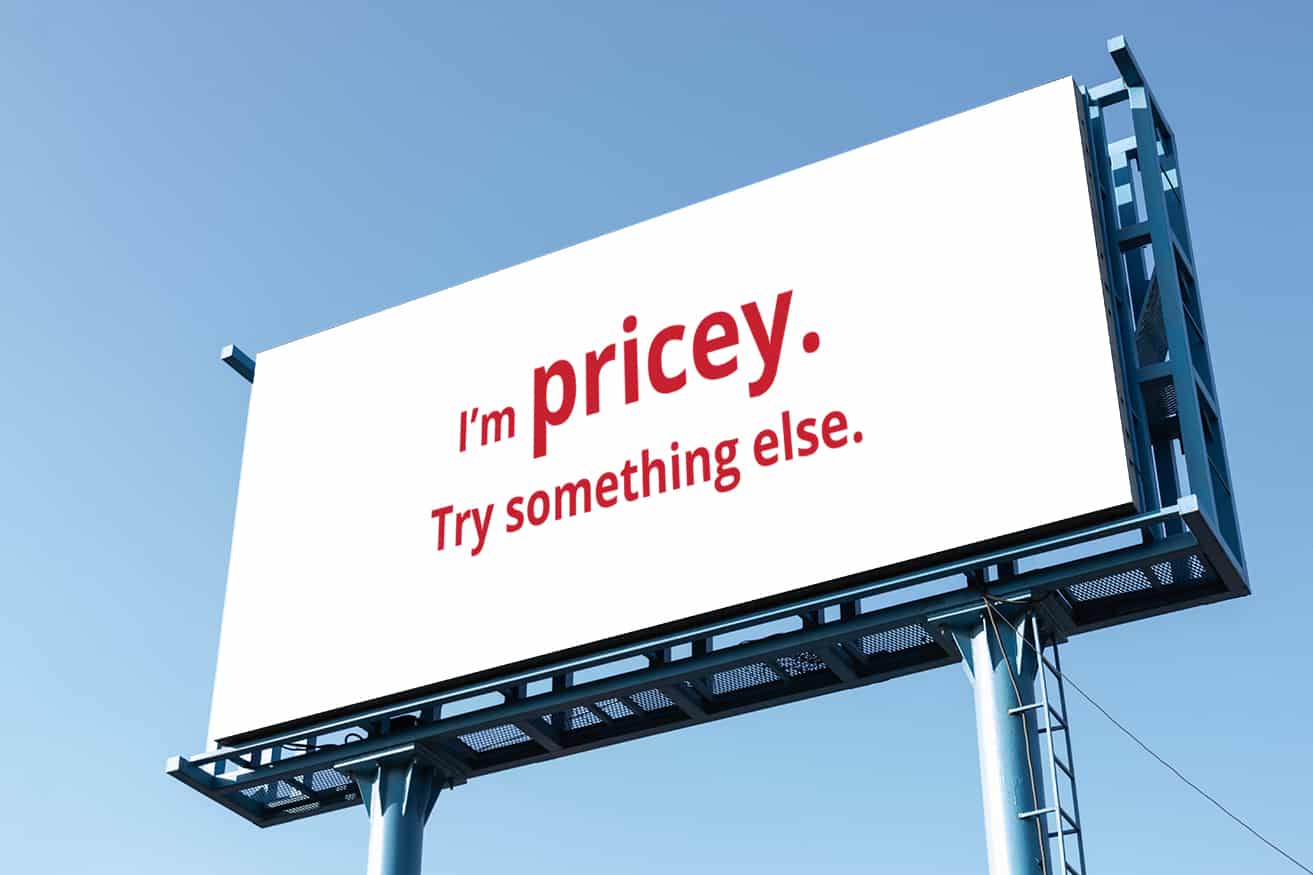
4
Retain Customers
What makes customers want to come back?
Of course it’s good food, drinks, atmosphere and your awesome staff. But truth be told, you can get that quite a few places these days. What can you do to get customers to choose your place to come back to?
1. Loyalty or Rewards Programs
Loyalty programs work because they make your customers feel like a VIP and you have the added benefit of more frequent repeat visits. That results in more profit. One study has found that increasing customer retention rates by 5% increases profits by at least 25% among returning guests.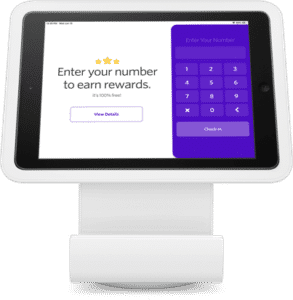 If you’re part of a franchise, there may be a program created for you. Be sure you are getting people signed up by promoting it. There’s a good reason why they’ve created a loyalty program for your use!
If you don’t have a program, now’s a good time to create it! This can be super low tech or high tech, from punch cards to magnetic stripe cards that work with your POS.
Offer something that will be enough of an incentive to return frequently so they can earn their reward. Be sure to track redemption of the loyalty program offers so you know how much additional revenue you’ve made as a result of your program.
Read more about customer loyalty in our blog, 6 Ways Restaurants Increase Customer Loyalty.
If you’re part of a franchise, there may be a program created for you. Be sure you are getting people signed up by promoting it. There’s a good reason why they’ve created a loyalty program for your use!
If you don’t have a program, now’s a good time to create it! This can be super low tech or high tech, from punch cards to magnetic stripe cards that work with your POS.
Offer something that will be enough of an incentive to return frequently so they can earn their reward. Be sure to track redemption of the loyalty program offers so you know how much additional revenue you’ve made as a result of your program.
Read more about customer loyalty in our blog, 6 Ways Restaurants Increase Customer Loyalty.
2. Email Marketing
Email marketing for your restaurant can work well to remind past customers to come back. Also, email marketing is:- Measurable – You know how well an email performed as long as you’re using an email marketing program (as you should be) like MailChimp or Fishbowl.
- Shareable – Encourage your customers to share your email filled with coupons or other offers.
- Cost-effective – There’s almost no cost involved in sending an email out. Most email marketing programs offer free services before you have to start paying.
Who to send emails to?
Sometimes it takes a little bit of effort to collect email addresses so you can send out an email. Offer a little incentive to customers who sign up for your email list. Offering $5 off their next visit or a free appetizer can be a great incentive. And be sure your staff is working hard to collect addresses. This is really important for growing your repeat business segment. It’s not a good idea to send emails to people who have never been into your restaurant. Never purchase an email list to send your email to. They are likely to unsubscribe because you have “spammed” them. The more often you’re marked as spam, the less likely your future emails will actually appear in your customers’ inboxes.What to Include In an Email?
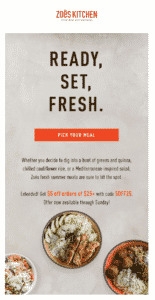 It doesn’t need to be a really long email and a picture is worth a thousand words, or so we are told. And you may want to change up the content each time you send one. Here are a few ideas:
It doesn’t need to be a really long email and a picture is worth a thousand words, or so we are told. And you may want to change up the content each time you send one. Here are a few ideas:
- A coupon / discount that you aren’t offering other places. Since you track coupon redemptions, you’ll know if your email campaign was effective.
- New menu items
- Featured staff members (ie: manager, hostess, bartender, etc.)
- “In honor of” days like National Pizza Day or National Margarita Day with any specials around these days.
How Often to Send Emails?
Once a month might be plenty, but don’t send emails more than once per week.3. Events at Your Restaurant
Promoting an upcoming event at your restaurant is good content for email marketing, social media posts (be sure to use the Public Event feature in Facebook), and a good opportunity to have a larger crowd on a night that might have otherwise been slow. Here are just a few ideas. Get creative about what would interest your target audience.- Have a movie night or show the big game in the parking lot. You can project on the exterior of your restaurant or get some of the blow-up screens that are easy to find and rent.
- Offer a free tasting event for wine, beer, whiskey or something else of interest to your customers.
- Recurring game nights at your restaurant. Bingo, trivia, or even outside sports if you have space.
- Theme night with prizes for those who dress up best in the theme you’ve chosen.
- Reach out to organizers at Meetup.com. Some groups meet once a week and most meet at least once a month.
- Think about offbeat holidays to celebrate: August 2nd is National Sister’s Day!, May 8th is No Socks Day (it’s a real thing) A little wackiness and a discount tied to the theme can be fun all the way around.
 It’s your current customers who are most likely to hear about this when they’re in your restaurant. But if your event is remarkable enough (like a parking lot water balloon party) it is highly likely that your loyal followers will share your event with their friends and family. People love to do something a little different. Give them a reason to come back and bring new fans!
It’s your current customers who are most likely to hear about this when they’re in your restaurant. But if your event is remarkable enough (like a parking lot water balloon party) it is highly likely that your loyal followers will share your event with their friends and family. People love to do something a little different. Give them a reason to come back and bring new fans! 5
Conclusion
What to Do First?
There’s a lot of information in here. And while it’s all important, you can’t really take it all on at once. Some of your decisions will be based on how far along you are in the life of your restaurant and/or the life of your marketing program.
- Be sure you always start out with a clear understanding of your restaurant’s finances. Use this to create a simple, achievable goal for increasing your profits.
- Use the RATE framework to compare the marketing tactics you’d like to use. The best mix of repetition, appeal, targeting, and exposure at the most affordable cost is the best way to get an ROI.
- Next, get the marketing essentials in place: your local listings, website, and your online reviews. If you’re in good shape there, or at least have an active plan for these, you can probably start moving to paid restaurant marketing activities.
- New vs Existing Customer Advertising Focus – Where to Start?
- If your restaurant is new to the area (less than 12 months), you will most likely need to focus on gaining as many first-time customers as you can. Make sure you’ve covered the basics first. . and then build your customer base by steady increments. Cash is king, especially when a restaurant is just starting out. Some paid marketing is more likely to get an ROI than others (based on RATE) so take some time and create a 6 and 12 month strategy, don’t just throw money at your advertising. Refer back to your downloadable worksheet to choose the marketing tactics that will be most effective for your new restaurant with the least amount of risk.
- If your restaurant is already established, new customers are still very important. This is the time to engage in paid marketing tactics that might be higher-risk, but also higher-reward. At the same time engage your existing customers. Send out an email if you haven’t in a while, host an event, or find another way to get those who love you to remember to choose you when they’re going out to eat next time.
- Continue with your restaurant’s advertising program, even in the good times. When you advertise, you rent your customers, you don’t buy them.When things are going well you might be tempted to back off of marketing. But, marketing is most likely a big part of why you’re doing well. Keep your foot on the gas and keep going forward so that you don’t run into an unnecessary lull in business by pausing your marketing efforts.
- Check back periodically to see how you’re doing on meeting your goals. Check on the ROI of your advertising. If something isn’t working, think about how to RATE better advertising. If after six months (or so) your advertising hasn’t generated a positive ROI, find a new opportunity for promotion and put it to the test. That’s why tracking everything you do is really important!
If you’d like help evaluating the types of promotions that might work best for your restaurant, our team is here to help. Our marketing consultants are experts in your local community and can advise you on what solutions will work best and what information you should include on your ad or coupon. Our in-house graphics team takes care of the design of your ad, and we handle the rest: printing, placement on receipts, and delivery of register tapes and shopping cart ads to grocery stores. The entire process is that easy.
Download a PDF version of this guide
Fill out this form


